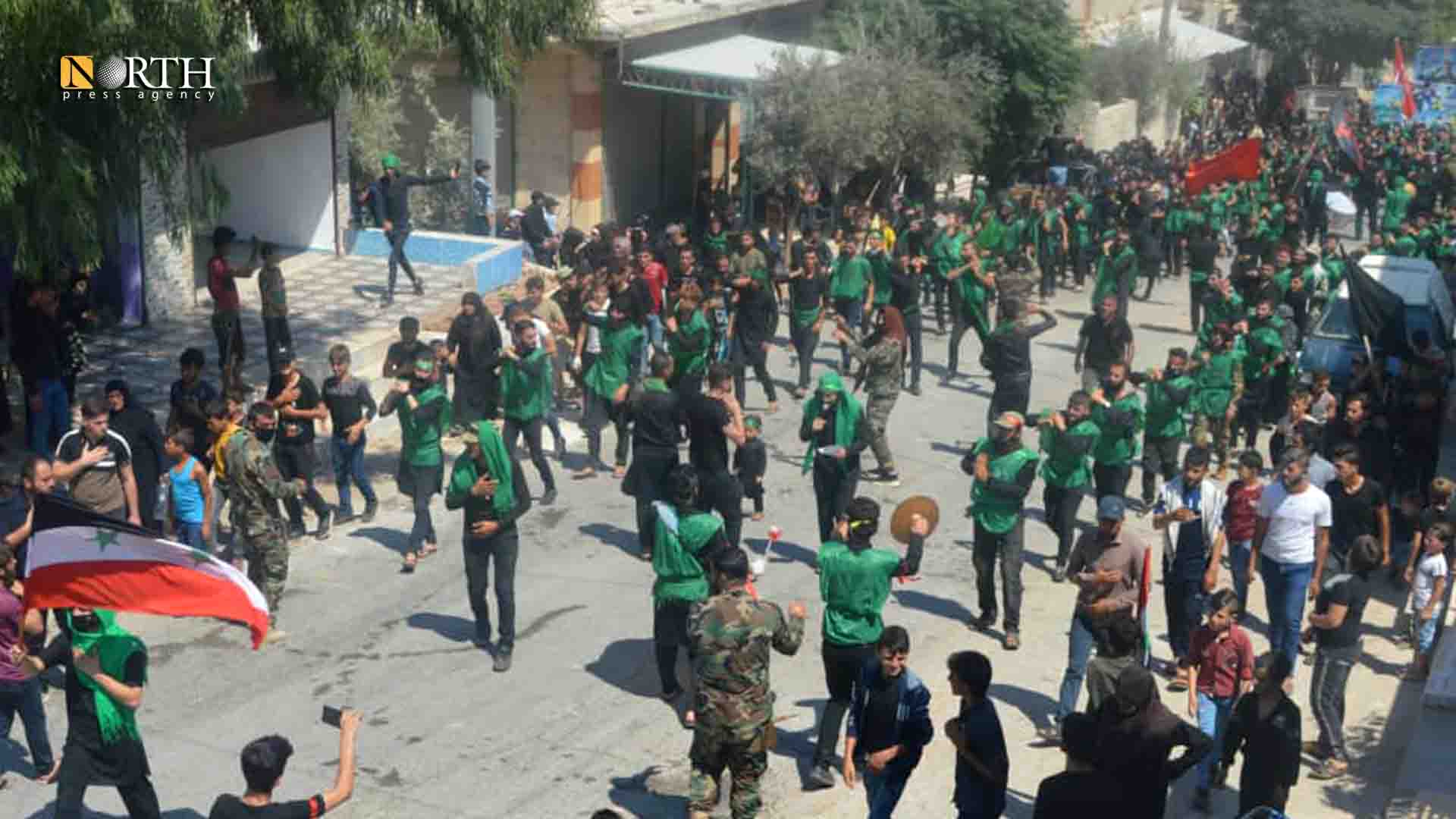ALEPPO, Syria (North Press) – The manifestations of Iranian culture dominate aspects of life in the Shi’ite Muslim towns of Nubl and Zahraa in the northern countryside of Aleppo, which was evident during the years of the war in Syria.
The population of the two towns is about 70,000 people. About 20 km from the city of Aleppo, the towns are administratively affiliated with the city of Azaz.
The manifestations of Iranian Shi’ite culture in the two towns are evidenced by the revival of the births and deaths of Shiite imams, the Ashura ceremonies, and the building of mosques.
The Iranian Shi’ite cultural tide coincides with the increasing presence of the slogans of jihad and resistance and the increase in the recruitment of young men, according to residents of the two towns.
The Beginning
Muhammad Ali Assaf, a lawyer concerned with cultural affairs, told North Press, “Iranian cultural activities in the two towns expanded with the opening of the Iranian consulate in Aleppo in 2008.”
Opposition factions seized the consulate center in the town of Haritan in the northern countryside of Aleppo during the war years, though it was retaken by government forces in February 2020.
Assaf added that “the two towns were secularized before the Khomeinist revolution in Iran in 1979, until Iraqi clerics arrived to start marketing to Khomeini.”
Assaf mentioned also that “These people met with objections in the beginning from notables and intellectuals, but the culture that Hezbollah and Iran are one was imposed on most of the people of Nubl, Zahraa, and the Shi’ites of Syria later.”
Assaf pointed out that the Iranian cultural tide escalated in the early 1980s with Khomeini’s ascension to power. Many families hung his picture as a Shi’ite symbol who rose up in the face of injustice.

Many young men were sent to Iran to study in its universities during that period, to return to the two towns, their minds saturated with the Guardianship of the Jurist theory, which justifies the rule of Islamic clergy over the state.
Secret funeral campaigns
Assaf noted that “during the rule of Hafez Assad, security services prohibited religious activities and restricted Shi’ite culture.”
Shi’ite campaigns were carried out secretly and cautiously, avoiding confrontation with the Sunnis during the rule of the senior Assad, in contrast to the rule of the son, when it became overt and at an accelerated pace, according to Assaf.
Assaf attributes the reason to the change in the nature of the relationship between Syria and Iran, which has become closer to subordination after an equal alliance during the era of Hafez Assad.
The first years of Bashar Assad’s rule witnessed the funeral campaigns of an organization that targeted Syrians, led by the Iranian embassy in Damascus and its cultural attaché in Aleppo.
After the outbreak of the Syrian war, they began to play their role directly on the scene of events, as the Shi’ite towns of Aleppo and Idlib were fortified and armed with various types of weapons.
Inborn debt
Mahdi Reda Fawaz, a 60-year-old retired professor, told North Press, “I remember in the eighties and until the late nineties, religiosity in our two towns was innate and did not need that religious system or cultural rituals that we see now.”
Fawaz pointed out its impact on the youth. “Even the names and clothes have changed…most families now impose the veil on their daughters at the age of no more than 11.”
In 2013, the two towns were subjected to a three-year siege by the opposition factions (Ahrar al-Sham, al-Nusra Front, and the Levant Front).
As for the northern side, it was under the control of the People’s Protection Units (YPG) in Afrin, as supplies were reaching the two towns from its side.
Fighters from Lebanese Hezbollah and militias affiliated with Iran were able to lift the siege on the two towns in 2016, with air support from Russian air forces.
In 2014, Syrian personalities accused the Iranian cultural advisor in Damascus of carrying out activities contrary to its stated goals, but Syrian Shi’ite clerics denied this.
Exaggeration?
Sheikh Ibrahim Jumah Jarada, an imam and preacher at the Abu al-Hassan mosque in the town of Zahra, said, “There is an exaggeration of the Iranian cultural role in Nubl, Zahraa, and the rest of the Shi’ite areas in Syria.”
“All the Shi’ites of the world have one cultural and religious principle, and as a result they are an Islamic group that has its own religious rituals,” he added.
War backfires
There are nearly dozens of Hussainiyas, or congregation halls for Shi’ite Muslims, in the two towns. The al-Misbah Association, based in Lebanon, practices its religious and educational activities through some committees.
The war contributed to changing many perceptions among the residents of Nubl and Zahraa, and a culture less committed to the religious rituals that Iran had marketed to them during the past years, according to some residents.
On the day of Ashura, which falls on the tenth of Muharram, which was revived in the town of Nubl, the procession lasted only one hour, while in the past, plays, banquets, and films were held with it.

